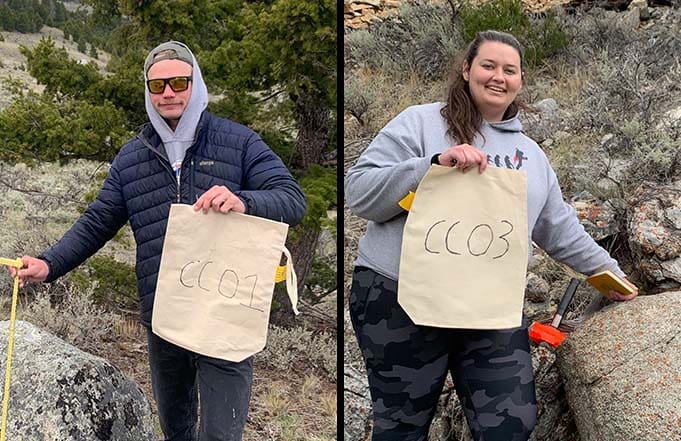October 11, 2021
University of Montana Western students, Mana Bryant and Will Larson, will travel to Portland, Oregon to present their results from a 2020 National Science Foundation (NSF) funded Pioneer Mountains research project at the Geological Society of America (GSA) Connects 2021 Conference October 10-13.

Led by Dr. Spruce Schoenemann of the Montana Western Environmental Sciences (ES) Department, this NSF funded collaborative project was a student-led research project conducted in the Pioneer Mountains, near Dillon, Montana, with the goal to reconstruct the glacial retreat history of the region. The unique combination of block scheduling and the proximity to the once-glaciated Pioneer Mountains, made the University of Montana Western an ideal place for undergraduates to engage in this project.
The Pioneer Mountains are one of the few ranges in western Montana underlain by granite, making it possible to use Beryllium-10 (10Be) for cosmogenic nuclide geochemical dating and produce the first moraine chronologies for the region.
The project first started in the Fall 2020 semester with University of Vermont professor, Dr. Lee Corbett, providing ES students and faculty a virtual training on the use of cosmogenic nuclides for geochemical dating. The training included proper field techniques on how to identify and sample glacial boulders that would provide accurate dates for glacial retreat in the Pioneers.
In anticipation of the research grant, Dr. Schoenemann offered a special topics course titled “Glacial Geology of Montana” where students learned about geochronologic dating methods, glaciology, regional weather/climate patterns, applications of radioactive isotopes, and the development of paleoclimatic reconstructions.

At the onset of the Fall semester, UMW students Mana Bryant and Will Larson were selected to join the research project under the mentorship of Dr. Schoenemann. During the winter months, Bryant and Larson used topographic maps, aerial photos, and Google Earth to perform topographic analysis of which glacial moraine sets would be the best candidates for dating.
Once the snow melted in the late spring, Bryant and Larson participated in a 10-day field session to map surficial glacial deposits and collect rock samples from multiple moraines. They spent several days in the lab looking at locations and photos to determine which were the least eroded boulders, which were the least likely to have rolled or toppled over, and which were least likely to have been buried substantially by seasonal snowpacks in order to choose the best samples for dating.
By taking samples of the granite rocks and utilizing the cosmogenic nuclides for geochemical dating, the students would then test the hypothesis that glacier systems, located in continental regions proximal to the Laurentide Ice Sheet (LIS) and thus experience both cold temperatures and exceptionally low precipitation, may have reached local ice maximum considerably earlier than the LIS.
Bryant and Larson then took these samples to the Montana Tech rock preparation facilities to crush, grind and sieve the samples down to 250-850 micrometers in preparation for testing at the NSF-supported community cosmogeny laboratory at the University of Vermont.
During the early summer, Bryant and Larson traveled to the University of Vermont for eight weeks to learn and perform the complete process of sample preparation under the supervision of Dr. Corbett. Once purified, they were sent to the NSF-supported PRIME lab at Purdue University. Bryant and Larson worked remotely with Dr. Marc Caffee to learn how accelerator mass spectrometry analysis is done to determine cosmogenic ages and to interpret the dates.

The ages that were determined from the Purdue University PRIME lab, and the data collected during the entire year-long project, will be presented at the GSA Connects 2021 conference by Bryant and Larson from October 10-13.
Larson’s poster titled “Glacial Mapping in the Arid Pioneer Mountains, Montana: Assessing Paleo-Elas during the Last Glacial Maximum” and Bryant’s poster titled “Investigating Arid Alpine Pleistocene Glaciation in the Pioneer Mountains of Montana using Cosmogenic 10-Beryllium” combine to cover the entire scope of the project.
“This NSF project has offered the students a unique set of opportunities, including involvement from the initial site selection through the entire process, particularly with the chance to travel and work at a state-of-the-art research lab. It doesn’t get more experiential than this!” said Schoenemann.
“When I first applied to college, I never would have imagined I would be standing here today, working with experts in their field and presenting what I learned at a national conference… all at an undergraduate level!” said Mana Bryant. “I hope to be able to continue being part of such fun collaborative projects after I graduate from Montana Western. The opportunities that arise for undergraduates here are truly experiential learning!”
For more information, please email spruce.schoenemann@umwestern.edu.